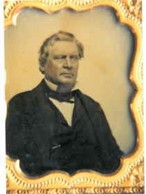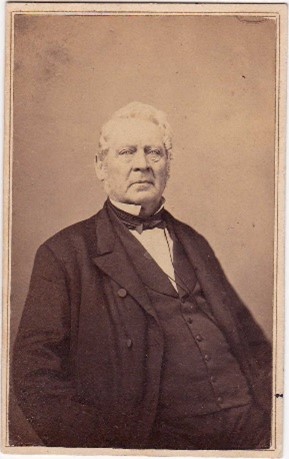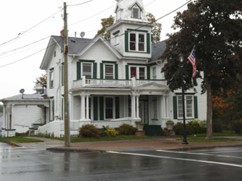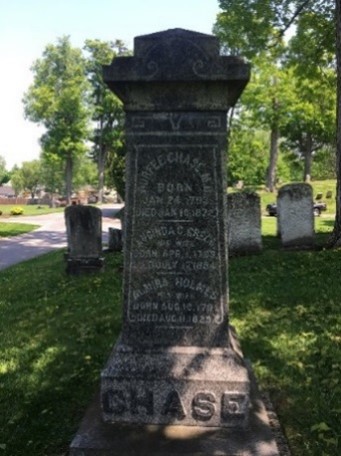



Durfee Chase, the oldest child of Clark Chase and Phebe Mason, was born on January 24, 1793 in Swansea, Bristol County, Massachusetts. Durfee is on our list of suspects because he was a brother of Willard and Sally Chase. (It should be noted that in the writings of Willard Chase, he makes no mention of his brother Durfee.) Durfee Chase is also on our list because of his association with Gain Robinson and Alexander McIntyre.
On June 20, 1792, the parents of Durfee Chase were married by Baptist minister Elder Benjamin Mason in Swansea, Massachusetts. In that community, Durfee’s father had a share in the Troy Manufactory Mill. In about 1803, the Chase family moved from Swansea to Rutland, Jefferson County, New York, a distance of 135 miles from Palmyra.
Resident of Palmyra from Eighteen years old until his Death
The Clark Chase family moved to Palmyra in 1811, when Durfee was age eighteen. Census records from 1820 to 1870 support the theory that Durfee Chase was a long-term resident of Palmyra. In the 1820 US Federal Census, Durfee was listed as having a household of one male age 26-45, one female under age 10, one female age 16-26, and one female age 26-45. In the 1830 US Federal Census, Durfee had a household of one male under age 5, one male age 30-40, one female age 5-10, one female age 10-15, and one female age 40-50. In the 1840 US Federal Census, his household consisted of two males under age 5, one male age 10-14, one male age 40-49, one female age 5-9, one female age 10-14, one female age 15-19, one female age 20-29, and one female age 40-49. In 1850, the names of Durfee’s household members were listed: Lucinda Chase age 50, Louisa G. Chase age 18, Winfield G. Chase age 14, Durfee C. Chase age 12, Julia L. Chase age 8, Lawrence H. Chase age 6, Alexander G. Austin age 27, Rolling Gregg age 22, Harry Taft age 2,; and Mary Ann Robinson age 25. In 1860, Durfee’s household members were again included. By 1870, his household included his wife Lucinda and their daughter Lavinia Hahnemann Chase age 26.
The Chase Family in Palmyra
Clark and Phebe Chase built a log house on farmland about thirty rods south of Palmyra. In this house, they lived with their children Durfee, Willard, Abel, Asa, Sally, Edwin, Parley, and Mason. [1] The well that supplied the family with water was dug by Joseph Smith Sr. and his sons in 1816. (In this well, Joseph Smith Jr.’s seer-stone was found). The well was open for viewing until the 1880s when it was filled in.
In 1811, Durfee sought medical training from Dr. Gain Robinson. His fellow students were Alexander McIntyre and Philander Packer. Durfee was trained to be a homeopathic doctor—one who professes that the body can cure itself, and if medicine is needed, the best source is natural substances like plants and minerals.[2] As for fellow student Alexander McIntyre, he became an allopathic doctor. The interest of student Philander Packer turned to farming. It should be noted that the paths of Durfee Chase and Alexander McIntyre crossed many times, but ended with a dramatic public altercation over Masonry.
War of 1812
Durfee’s work as a doctor in Palmyra was interrupted on June 18, 1812, when the US Congress declared war on Great Britain.[3] John Swift, founder of Palmyra, was appointed brigadier general of a military unit composed of Palmyra residents age 18-45, who were called to the colors in the emergency.[4] During the war, Durfee held the rank of captain of the Independent Company of Light Horse Cavalry. He fought in strategic battles of the War of 1812, such as the battles at Niagara, Pultneyville, and Sackets Harbor.[5] The Treaty of Ghent ended hostilities of the War of 1812 by formal ratification on February 17, 1815.
Durfee becomes a Young Man of “high standing” in Palmyra
Medical Doctor. In 1814 at age twenty-one, Durfee Chase returned to Palmyra and established his medical practice. The reason for his early return to Palmyra in the War of 1812 is unknown. His first medical office was located on Clinton Street next to his residence at the corner of Canal and Clinton Streets.
On January (June) 2, 1823, Durfee Chase was present at a meeting of physicians and surgeons held in the Presbyterian Church in Lyons, New York. The purpose of the meeting was to organize a medical society in the county. With Dr. Gain Robinson presiding, Durfee Chase was “found competent and authorized to practice medicine and enrolled his name.”[6]
Mason. Through a stringent selection process, Durfee became an initiate of the Masonic Mount Moriah Lodge No. 112. He was appointed secretary of the lodge in 1815. Through the years Durfee filled many important masonic offices. From 1821 to 1824, he served as the elected master of the lodge. During that interim, he also was named grand master in 1822. He was elected high priest and master of the Palmyra Eagle Chapter No. 7 of the Royal Arch Masons in December 1823. In 1825, Durfee was expelled from the Royal Arch Masons for “un-masonic conduct,” with Alexander McIntyre testifying against him. However, when the lodge was reorganized in 1853, Durfee was named an honorary member.
Marriage. Durfee married Almira Holmes in 1816. Almira died seven years after their marriage on August 11, 1823.[7] One month following her death, their only known child died.
One year later, Durfee married Lucinda Campbell Gregg, daughter of Hugh Gregg of Greenville, New Hampshire, on August 1, 1824 in Palmyra. To their union were born seven children. Durfee and Lucinda were the first to sign the rolls of the Zion Episcopal Church in Palmyra.
Military Service. Although it appears that Durfee left his military appointment before the War of 1812 ended, his affiliation with the military remained constant for twenty years. On March 17, 1821, Governor DeWitt Clinton of New York appointed Durfee Chase an ensign in the 39th Regiment of Infantry in Ontario County, New York. Serving in the same infantry unit were Thomas Rogers II (colonel), Nathaniel Beckwith (captain), Alexander McIntyre (surgeon’s mate), and George Beckwith (lieutenant).[8] In 1837, Durfee was commissioned by Governor William L. Marcy of New York as brigadier general of the 24th Brigade 22nd Division of Infantry. In the same year, Durfee resigned from his military position and received an honorable discharge.
Religious Persuasion. On July 7, 1821, Durfee deeded to the Methodist Church property on Vienna Road in Palmyra.[9] Although the deed suggests that Durfee was a Methodist, he willingly ended his affiliation with Methodism when he married Lucinda Gregg in 1824 and joined the Zion Episcopal Church.[10] Durfee contributed to the building fund of the Zion Episcopal Church. In 1831, the name of Lucinda Chase was listed in the first confirmation class of the Zion Episcopal Church.[11]
“Testimony of 51 Neighbors” on December 4, 1833
It does not appear from historical records that Durfee had any relationship with Joseph Smith Jr., Martin Harris, or the Book of Mormon. However, when Doctor Philastus Hurlbut came to Palmyra in 1833 and stayed for over a month, lecturing and collecting statements from November to December, Durfee was one of fifty-one residents of Palmyra to sign his signature to an affidavit denouncing Joseph Smith, Martin Harris, and the Book of Mormon:
Testimony of Fifty-one Neighbors
Palmyra, December 4, 1833
We, the undersigned, have been acquainted with the Smith family for a number of years, while they resided near this place, and we have no hesitation in saying, that we consider them destitute of that moral character, which ought to entitle them to the confidence of any community. They were particularly famous for visionary projects, spent much of their time in digging for money which they pretended was hid in the earth; and to this day, large excavations may be seen in the earth, not far from their residence, where they used to spend their time in digging for hidden treasures. Joseph Smith, Senior, and his son Joseph were in particular, considered entirely destitute of moral character, and addicted to vicious habits.
Martin Harris was a man who had acquired a handsome property, and in matters of business his word was considered good; but on moral and religious subjects, he was perfectly visionary—sometimes advocating one sentiment, and sometimes another. And in reference to all with whom we were acquainted that have embraced Mormonism from this neighborhood, we are compelled to say, were very visionary, and most of them destitute of moral character, and without influence in this community; and this may account [for] why they were permitted to go on with their impositions undisturbed. It was not supposed that any of them were possessed of sufficient character or influence to make any one believe their book or their sentiments, and we know not of a single individual in this vicinity that puts the least confidence in their pretended revelations.
On December 13, 1833, Durfee also provided a testimony against Joseph Smith in support of Peter Ingersoll’s statement: “I certify that I have been personally acquainted with Peter Ingersoll for a number of years, and believe him to be a man of strict integrity, truth and veracity.”
In 1840, Durfee became a disciple of Dr. Hahnemann, a German physician, who established principles of homeopathic medicine. He was so taken by this German doctor that he gave his youngest daughter Lavinia the middle name of Hahnemann. Dr. Chase liked to treat diseases by giving small quantities of chemicals.
Durfee Chase from 1843 through the 1860s
In 1843, Durfee Chase moved his medical office to the Horton Block of Palmyra, where he trained medical students. One man wrote, “His office always had some quiet nook or rear room whose sides, lined with books, presented the appearance and gave the air of a mental shop . . . when he undertook a case, he bent his energies to effect a cure with no thought of pecuniary reward.” His student Samuel O. Scudder married Durfee’s daughter, Harriet Fidelia Chase. Another student was his nephew, Rollin R. Gregg.[12] In 1845, Durfee moved his medical office to the Clemons Block on Main Street. That same year, he was awarded two dollars for an erroneous tax on a dog by the town clerk of Palmyra.[13]
In the early 1850s (years not specified), Durfee sold his house at the corner of Canal and Clinton Street and purchased a house on Main Street. The house had a small office attached to the front, where Durfee practiced medicine. In 1850, he was elected vice president of the New York State Medical Society.
In his later years, Durfee received honorific recognition. He was named an honorable member of the Palmyra Masonic Lodge No. 248 when it was organized in 1853. On June 6, 1855, Durfee was invited to attend the twelfth annual session of the American Institute of Homeopathy held at the American Hall in Buffalo, New York.[14] Durfee was elected president of the Wayne County Homoeopathic Medical Society on February 9, 1864, holding the office until 1865. He became famous for his writings on homeopathic remedies for seasickness.[15] Due to this recognition, it is not surprising that people took notice when Durfee Chase became an early advocate of the Temperance Movement.
In his old age, Durfee became careless in his payment of city taxes. In 1862, Durfee was listed as a physician owing $10 in taxes.[16] In 1863, he was listed as a physician owing $6.64 in taxes.[17] In 1866, he owed $10 in taxes. He paid the 1866 tax bill in full.[18]
Death of Durfee Chase
On January 10, 1872, Durfee Chase died at age seventy-nine. At the time of his death, he was residing with his daughter Mrs. George McGowen on Washington Street in Palmyra. By the time of his death, Durfee had sold his place on Main Street.[19] Funeral services for Durfee Chase were held in the Zion Episcopal Church at 2 p.m. on January 12, 1872.[20] He was buried with full masonic honors in the Palmyra City Cemetery.
At age eighty-three, Lucinda Chase wrote a letter to US President James Garfield to protest the admission of Utah Senator Abraham O. Cannon to the US Congress. She was very much against polygamy. President Garfield was shot in July 1881, and may never have received her letter. Lucinda Chase died on July 14, 1884.
Children of Durfee Chase and Almira Holmes
1. Susan Ann Chase (February 1819–September 27, 1823).
Children of Durfee Chase and Lucinda Gregg
1. Harriet A. Chase (March 28, 1825–January 29, 1855). She was born in Portsmouth, Rhode Island. She married Samuel Osborn Scudder (1814–1895) on December 24, 1845.
2. Jackson Holmes Chase (January 23, 1828–August 14, 1875). He was born in Palmyra. He married Harriet Huxley on December 15, 1857. He worked as a physician. He went to sea on a whaling ship, and became a seafaring officer in the Union Army. He wrote books about his adventures and became a 33rd degree mason. He died at sea near Sandy Hook, Connecticut.
3. Louisa Gregg Chase (February 7, 1832–October 23, 1920). She was born in Palmyra. She was married to Franklin Lakey on April 16, 1866.
4. Winfield Scott Chase (October 17, 1835–June 3, 1910). He was born in Palmyra. He married Elizabeth Parkins on February 19, 1861 in St. Louis, Missouri. He later married Georgiana Virginia Spear on May 19, 1874 in Fairfax County, Virginia. Winfield was a veteran of the Civil War. During the war, he was wounded in a wrist. Following the war, he was a US patent officer in Washington DC. He died in Chevy Chase, Maryland. He was buried in the Rock Creek Cemetery in Washington DC.
5. Durfee Clark Chase (April 22, 1838–July 20, 1919). He was born in Palmyra. He married Harriet Hutchinson on August 27, 1862. He was a bridge tender for a railroad company. He died in Syracuse, New York.
6. Julia Lucinda Chase (April 24, 1841–October 27, 1919). She was born in Palmyra. She was a talented soprano, but gave up a promising career to marry George McGowen on September 7, 1864. She was buried in the Palmyra City Cemetery.
7. Lavinia Hahnemann Chase (June 15, 1843–January 2, 1905). She was born in Palmyra. She did not marry. She was a translator in the office of Foreign Mail, and created the first USO Facility in Washington DC, which served troops in the Spanish American War.
[1] Correspondence with Cody Crider, a direct descendant of Abel Durfee Chase, February 17, 2018.
[2]The Great Physician: A Sermon on occasion of the Death of Alexander McIntyre, M. D., delivered in the Presbyterian Church, Palmyra, N. Y. July 24, 1850 by Horace Eaton, pastor of the Church (NY: John F. Trow, 377 & 379 Broadway, 1860).
[3] Current, Williams, and Freidel, American History: A Survey, p. 200.
[4] Clark, Military History of Wayne County, New York, pp. 245–246.
[5] Cook, Palmyra and Vicinity, p. 15.
[6] Landmarks of Wayne County, New York, p. 121.
[7] Correspondence from Wilber Walters, June 4, 1969, in author’s possession.
[8] Clark, Military History of Wayne County, New York, p. 165.
[9] Deeds of Ontario County Book 6:345.
[10] “Durfee Chase File,” in Palmyra Community Library.
[11] “Durfee Chase File,” in Palmyra Community Library.
[12] “Death of Dr. R. R. Gregg,” The Buffalo Commercial (Buffalo, NY), August 5, 1886.
[13] Palmyra Town Minutes, 1845.
[14] “Twelfth Annual Session of the American Institute of Homeopathy,” Buffalo Daily Courier (Buffalo, NY), June 7, 1855.
[15] Landmarks of Wayne County, New York, p. 124.
[16] US IRS Tax Assessment Lists, 1862–1918.
[17] US IRS Tax Assessment Lists, 1862–1918.
[18] US IRS Tax Assessment Lists, 1862–1918.
[19] Bonnie J. Hays, Palmyra (NY: Arcadia Publishing, 2004); Bonnie J. Hays, “Notable Palmyra Residents involved in Civil Rights Movement,” Monroe County Post, 2017.
[20] Durfee Scrapbook No. 2, 1864–1875.
